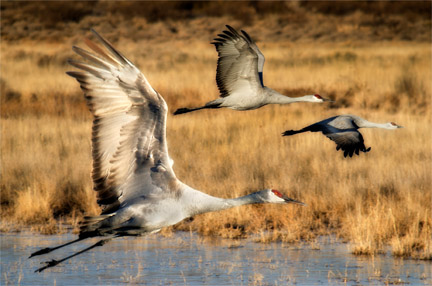
Our Wingtips tour of National Wildlife Refuges moves on to Region 2 of the Fish & Wildlife Service and brings us to New Mexico’s Bosque del Apache NWR. Known to many as simply “the Bosque,” the refuge is located on the northern edge of the Chihuahuan Desert and consists of more than 57,000 acres along the Rio Grande. The heart of the Refuge is 13,000 acres of moist bottomlands – active floodplain and areas where water is diverted to create extensive wetlands, farmlands, and riparian forests. The surrounding uplands are arid foothills and mesas, rising from a floodplain elevation of 4,500 feet to the Chupadera Mountains on the west (peak elev. 6,272 feet) and the San Pascual Mountains on the east.
The refuge’s name translates as “Woods of the Apache.” Native Americans often camped in this riverside forest. The area was occupied by Pueblo peoples; in the 16th century, it was explored by the Spanish, who built a Camino Real from Mexico City to Santa Fe through the refuge’s territory. The first water impoundments were constructed in the 1930s by the CCC, and the refuge was officially established in 1939.
The rock star of the refuge’s wildlife is the Sandhill Crane (Grus canadensis). Up to 17,000 of these stately birds spend the winter at the Bosque. Attendees of the annual Festival of the Cranes, based in nearby Socorro and hosted by the Friends group, enjoy lectures, tours, and workshops. At the same time, a blizzard of geese can accompany the cranes: Snow, Ross’s, Canada, Cackling, and Greater White-fronted Geese. This year’s cranes festival is coming soon: it takes place from 19 to 24 November. Gambel’s Quail and Greater Roadrunner are two more specialty birds of the refuge. Among mammals, the refuge’s wildlife checklist lists Mule Deer as common and Javelina as fairly common.
The refuge is host to a range of research and monitoring projects: exploring water use by phreatophye plant communities (like cottonwoods), radio tracking a subspecies of Meadow Jumping Mouse (Zapus hudsonius luteus) (endangered in New Mexico), analyzing earthquakes along an active fault that crosses the property, and prototyping a GPS telemetry system for migratory waterfowl. A 17-minute video highlights the “intensive habitat engineering” that is part of the job of managing the refuge.
Finally, stamp supporters should all know how much of the Bosque del Apache NWR was acquired through the MBCF/Stamp funding. It has been an amazing 99.2 percent!
This National Wildlife Refuge profile first appeared in the 9 October 2013 issue of Wingtips.